- A regulation issued earlier this year in Cambodia’s Koh Kong province purported to take land from protected areas and grant the land titles to families living in the area.
- But developments since then, and interviews with residents and brokers, paint the scheme as a massive land grab orchestrated by the country’s political elite.
- Politicians and companies have been snapping up the newly degazetted land, among them a firm suspected of being a front for pulpwood giant APP.
- Among those said to be profiting from the land grab is Ly Yong Phat, dubbed “The King of Koh Kong,” a politician and businessman with a long history of quashing the rights of those who occupy land he desires.
PHNOM PENH, Cambodia — In July, conservationists in Cambodia sounded the alarm over a regulation that saw eight protected areas in Koh Kong province collectively lose territory twice the size of Phnom Penh, the country’s capital.
Officials said the move, affecting nearly 127,000 hectares (314,000 acres) under Sub-decree No. 30, was meant to grant land titles to communities living throughout the protected areas.
But an investigation spanning six districts of Koh Kong supports conservationists’ concerns that the sub-decree would be abused by Cambodia’s wealthy elite.
While the sub-decree was signed into law in March 2021 and made public in May this year, a Mongabay investigation has revealed that an opaque network of land brokers has been buying up land in former protected areas listed in Sub-decree No. 30 as early as January 2021, and appears to have been orchestrated in part by National Defense Minister Tea Banh and his brother, Tea Vinh, the head of the Royal Cambodian Navy.
Communities across Koh Kong, along with civil society groups, have grown increasingly concerned that Cambodia’s latest land-titling expedition is being exploited by politically connected private interests. Sources say these interests are obfuscating land purchases through an extensive network of brokers and middlemen, essentially preventing communities from receiving the promised land titles.
“That’s how they do it, they send some people out here, they count up how many families live here so they can calculate how much land they can take from us,” said Dara, who owns a guesthouse in Tatai Kraom, a commune, or subdistrict, in Koh Kong province. Dara requested that his full name not be published for fear of retribution from investors and the local authorities who are said to enable them.
Its hilltops pooled in mist and doused in torrential rain, and the verdant greenery that made Tatai Kraom such an attractive location for ecotourism prior to the pandemic could soon be lost, Dara said, adding that vast swaths of untouched forest are set to be cleared from the 144,275-hectare (356,511-acre) Tatai Wildlife Sanctuary.
Listed as a protected area on May 9, 2016, Tatai Wildlife Sanctuary is one of the eight protected areas across Koh Kong that collectively lost 126,928.39 hectares to the sub-decree. But Tatai stood out as an area of concern due to the inclusion of large uninhabited forests among the 26,103 hectares (64,502 acres) cut from the wildlife sanctuary.
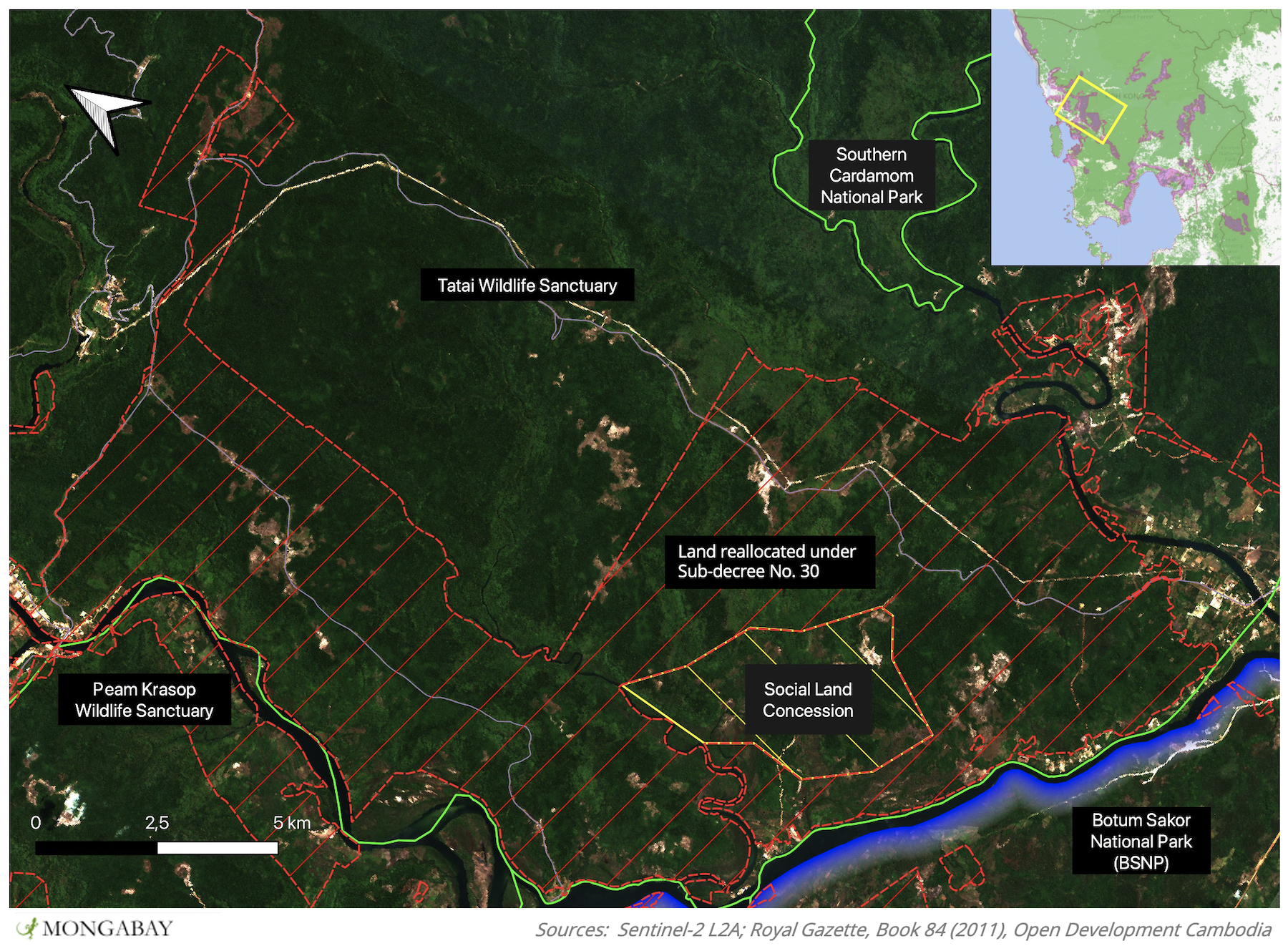
“They come, the government, they say that people need land in the forest and they give them maybe 1 hectare or 2 hectares each [2.5 to 5 acres] for farming, but they only ever offer us soft land titles,” Dara told Mongabay reporters who visited the region and interviewed residents in August 2021.
Soft land titles confer no formal legal ownership of the land upon their bearers and are only recognized by local authorities. Because of this, land grabbers have been known to bribe commune chiefs to forge predated soft land titles that supersede those of the legitimate landowners.
Officials reportedly have even been bribed into evicting communities holding soft land titles, whereas hard land titles make such land grabs more difficult — although not impossible — as they’re issued at the national level by the Ministry of Land Management.
“Then, when enough land has been cut for farmers, the buyers swoop in — they’ve been offering farmers $2,000 per hectare — but then they sell it on to bigger buyers at far higher prices, and those who don’t sell get pushed off the land by the new owners because they only have soft land titles,” Dara said. He added he saw this process take place in Koh Kong’s Botum Sakor district, where land grabs orchestrated by Tianjin Union Development Group (UDG) have been well-documented.
“The problem is the land prices, they’re crazy!” Dara said. “When farmers clear land, they take a small piece, just enough to grow some fruit, but now the land is so expensive and people are buying it all up, they’re coming here with excavators and clearing hectares at a time.”
Dara said the government is in the process of relocating the community living beneath the 246-megawatt Stung Tatai hydropower dam, which was built for $540 million by China National Heavy Machinery Corporation in 2014.

According to government documents and interviews with locals, the community will be moved to an area within Tatai Wildlife Sanctuary degazetted by Sub-decree No. 30. Satellite imagery shows the proposed site is currently comprised of uninhabited old-growth forest.
But Dara said the relocation is merely a way for investors to acquire more land, noting that the soft land titles the relocated community have been promised offer limited protection against powerful interests involved in land speculation and development.
Thin Sambath, the Tatai Kraom commune chief, could not be reached for comment, despite multiple attempts to contact him and his office.
Politically connected networks of land brokers
On the other side of Tatai Kraom, 60-year-old Su Phon was adjusting his prosthetic leg while rain hammered down on the tin roof of his house where he has lived since 1983.
“I’ve lived here happily with my four children and their families on this 1-hectare plot since before the Khmer Rouge. But earlier this year — I don’t remember when exactly — some people from Phnom Penh came, they wanted to buy my land,” he said, adding that he rejected the offer and cut short the negotiations by showing the would-be buyers his hard land title from 1983.
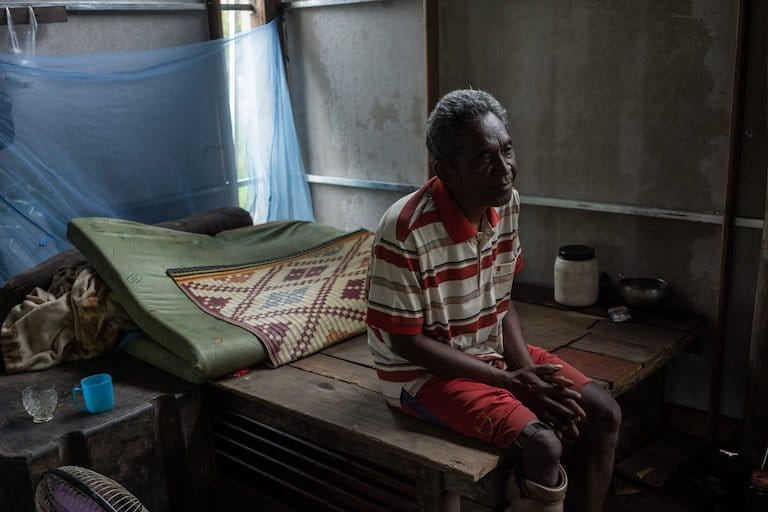
However, while Phon refused to sell his land, he said his neighbors were talked into selling theirs.
Phon said neither he nor his son-in-law, Yann, have met their new neighbors, but that a lake on the sold tract has since been filled in. Phon and his family had depended on water from the lake to irrigate their fields, and he said its removal caused their rice crop to fail.
Yann has been out of work since the construction industry ground to a halt under the strain of the COVID-19 pandemic, but appeared to be unfazed by the recent spate of nearby land sales.
“No, I’m not worried, even though the land prices are rising and I can’t afford to buy my own land or even build a house, this here is our ancestral land, nobody would take that from us,” he said.
But whether Yann and his family will be able to cling to their ancestral land amid the apparent Koh Kong land rush remains to be seen. Hour In, a human rights monitoring officer at local rights group LICADHO, was skeptical of the sub-decree’s intentions, given its origins, warning that it increasingly looked like a ploy to secure formerly protected land for some of Cambodia’s wealthiest.
“Actually, it was Defense Minister Tea Banh who proposed the cutting of land from protected areas to give land titles to the communities,” In said, adding that he, too, is attempting to secure his own land title through the sub-decree — without much success.
He said that while the move looked good for Tea Banh, that may have been precisely the point as the land allocated under the sub-decree has been hotly disputed for years. Token handouts of land have typically preceded elections, and analysts have suggested that Sub-decree No. 30 may be a means of placating an otherwise aggrieved community ahead of the 2022 commune elections and 2023 national elections in Cambodia.
“There have been many problems in the allocated areas,” In said. “When people tried to build houses, they were torn down and people were arrested, so part of the land titling is to stop protests, but there are also development plans at work — the land allocated by the sub-decree is far too big for just land titling; I suspect very rich people are also involved.
“If they sincerely wanted to solve this problem, they’d have done it 10 years ago,” he added. “You can’t overlook the fact that Tea Banh will find ways to benefit from appearing to address the problem.”
But while Tea Banh may be presenting himself as the savior of Koh Kong, sources say his brother, navy chief Tea Vinh, is actively orchestrating a fire sale of land throughout the province.
Protected land sold off by Cambodia’s elite
“My husband works for Tea Vinh,” said one guesthouse manager in Koh Kong district, part of Peam Krasop Wildlife Sanctuary. The sanctuary lost 7,235 hectares (18,100) to Sub-decree No. 30, despite being home to one of the largest and best-preserved mangrove forests in Southeast Asia.
“He used to work with him and the Royal Cambodian Armed Forces [RCAF] in the construction of roads,” she explained. “But earlier this year, he was tasked with bringing buyers here.”

It was around that time when the RCAF began building a road that will run from Peam Krasop Wildlife Sanctuary leading to the water’s edge of the Tatai River, where a bridge will be built to Chroy Pros commune. The guesthouse manager, who requested anonymity as Tea Vinh owns the guesthouse she operates, said this was just a small part of the plan to transform Koh Kong.
“My husband brings people here to buy land throughout Koh Kong,” she said. “It’s mostly policemen from Koh Kong, but next week we’ve got a group of 10 people from Phnom Penh who will come to buy a 30-hectare [74-acre] plot of land on behalf of a tycoon. I can’t say who and I don’t know the price.”
Cambodia lost an estimated 42% of its mangrove forests between 1989 and 2017, by which point Koh Kong was home to 79.8% of the remaining mangroves. While the guesthouse manager could not say where the land sale was taking place, she urged reporters to buy land on Koh Sralau, a small fishing village in the heart of Peam Krasop’s mangrove forest, as her husband could guarantee a price of $1,500 per hectare, adding that the value of the land would only increase as Peam Krasop Wildlife Sanctuary was developed.
“My boss [Tea Vinh] owns so much land, plenty here and some in Kampot province too, but Koh Sralau is his and Tea Banh’s hometown, so they really want to develop it,” she said. “They’ll finish building a bridge across the Tatai River through the mangroves connecting Peam Krasop Wildlife Sanctuary to Koh Kapi Ramsar site in 2022.”
When reached for comment, Tea Vinh initially said he couldn’t speak English and hung up on reporters. He was then contacted again twice in Khmer, but each time refused to discuss the matter and hung up.
But while Cambodia’s top navy official wasn’t prepared to speak, another Koh Kong resident employed by his brother, Tea Banh, was.
Dong Mith is one of the men helping build the road that cuts through Peam Krasop Wildlife Sanctuary that will link up with the bridge referred to by the guesthouse manager. But his living situation speaks to a broader problem of land value in Koh Kong.
“Tea Banh and [Prime Minister] Hun Sen are the ones who want the bridge, I’m just a laborer,” said Mith, who lives with his parents and grandmother on an island within Peam Krasop Wildlife Sanctuary that was delisted by the sub-decree. “I don’t even know the name of the company that pays my salary, but the bus driver who takes us all to the site each day wears RCAF uniform.”
The bus, he said, even has an RCAF license plate. Construction started in April 2021 and work has been “non-stop” according to the 44-year-old laborer, who said the road will connect to a bridge being built from Koh Sralau by a Chinese company.
Mith said he was thankful for the work, given that his family lives on an island they don’t own.
“Well, we’ve been here for around 20 years,” said Mith’s mother, Lieng. “My husband has been here since 1997, but there are only three other families on the island. None of us own it, we’re just looking after it for Bun Thoeun, he’s a politician in Phnom Penh, he never really comes here, he is an ‘excellency’ after all.”

Lieng said Bun Thoeun pays her family $100 a month to live on the island to ward off opportunistic land grabbers.
Mith’s father, Bin Dong, said Bun Thoeun intends to develop the island into an ecotourism resort, but when asked what will happen to his family and the others living on the island, Bin Dong said he’d been given assurances from Bun Thoeun that they would be “taken care of.”
“He will help us find somewhere else, so long as we reject all offers to sell this land to other people,” said Bin Dong, who added he’d turned down offers of $700,000 for their plot, despite not owning the land.
The family wasn’t willing to share Bun Thoeun’s details, nor were they willing to say which ministry he supposedly works for in Phnom Penh, citing reprisals that could leave them homeless.
An environment destabilized
Cautious not to give away any identifying information as his wife is sick, Chantra, who lives in a village within Peam Krasop Wildlife Sanctuary, could only say that his job takes him around the protected area and that he had recently been told by local authorities and residents that evictions were imminent on Koh Sralau and on neighboring islands.
“The local authorities came and took names of people on Koh Sralau, but not many there have land titles and they won’t give people full ownership of the land,” Chantra said. “Land across all these islands is being sold now.”
Some islanders are excited to relocate for the prospect of better amenities and livelihoods, he said, but those who own land are now staring down the barrel of eviction.
“The fisheries are destroyed,” Chantra said. “No fish, no crab, no shrimp. People used to make good money living on Koh Sralau and the surrounding islands, but for many, there’s simply no reason to stay.”
The evictions have met little resistance, he said, because sand-dredging activities throughout the mangrove forests of Peam Krasop Wildlife Sanctuary have more or less exterminated the fish population and killed off much of the local industry in the process.
In Peam Krasop Wildlife Sanctuary, some 90% of fish were species that relied on the mangroves. But that habitat is rapidly being eviscerated to make way for the ambitions of Koh Kong’s elite. Satellite data from the University of Maryland show tree cover loss has increased in and around Peam Krasop’s mangroves in 2021, as well in adjacent rainforest.
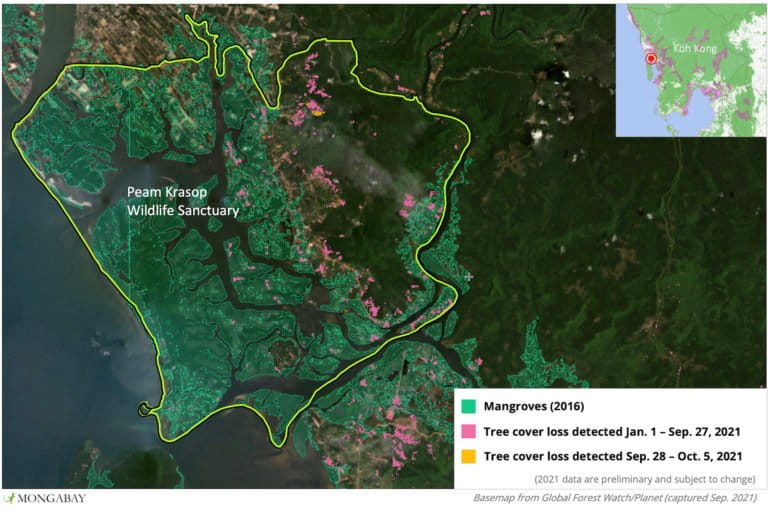
Chai Sokundy, a 60-year-old fisherman from Koh Sralau, said he can expect to catch just 10 to 20 kilograms (22 to 44 pounds) of fish each day, perhaps 30 kg (66 lb) if he’s lucky. That’s down from 60 kg (132 lb) a day 10 years ago.
“I’ve lived here for more than 30 years and I honestly don’t know what else I can do with my skills,” Sokundy said.
Hun Sen ordered a ban on the export of sand in 2009, but this did little to stop sand mining by Cambodia’s most powerful, who garnered international attention following a 2010 report from environmental watchdog Global Witness that suggested politically connected tycoons were skirting the ban and exporting sand worth $250 million each year.
“Sand dredging destroyed many of the smaller islands. That’s not something that men like me can do. It’s the same for the forests, who destroys them?” Sokundy asked before answering his own question. “It’s always powerful men.”


Few Cambodians are as powerful as Ly Yong Phat, dubbed “The King of Koh Kong” and known nationwide for his business interests quashing the rights of those who occupy land he desires.
His various sugarcane ventures have resulted in longstanding land disputes across Koh Kong and Kampong Speu provinces, but as a ruling party senator and one of the most powerful tycoons in the country, his portfolio extends far beyond sugar. Sand dredging was once a business he engaged in, although in recent years the King of Koh Kong appears to have stepped back from mining his kingdom’s sand.
Profiteering off Sub-decree No. 30
“The sand dredging at Koh Sralau was first owned by Ly Yong Phat, but he sold it after all those youth groups protested,” said one land broker who did not wish to be named or to name the people he represented.
According to the land broker, who would not reveal how he knew such things, the protests cost Cambodia’s sand mining companies more than $700 million; but while apparently abandoning his pursuit of profits in sand, Ly Yong Phat remains reluctant to allow for much competition in Koh Kong.
“If he opens freely, Koh Kong will be full of many Chinese companies like in Preah Sihanouk province,” the land broker said, referring to the once-sleepy beach town of Sihanoukville that’s been transformed in recent years by billions in Chinese investments. “Many parts of land in Koh Kong are now available.”
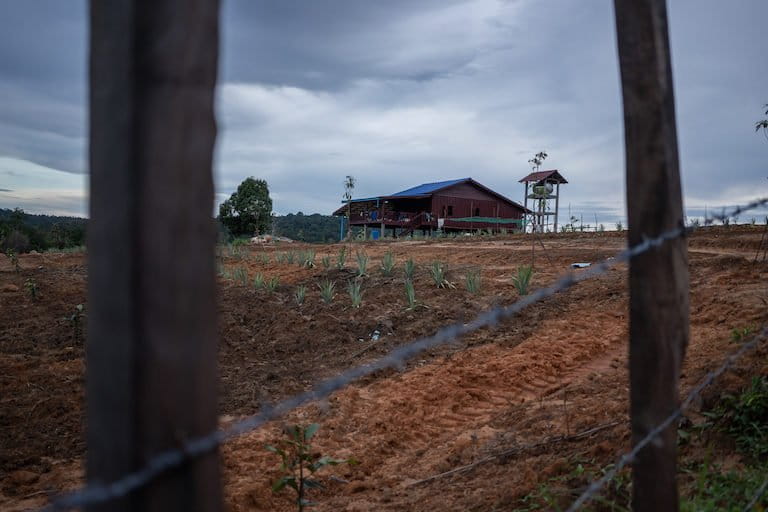
He added that Ly Yong Phat isn’t just rich, “but also powerful. All the people who work for the public sector in Koh Kong get a salary from Ly Yong Phat,” the broker said. “Thai money supports leaders in Koh Kong to be influential.”
He went on to detail the Thai heritage of all of Koh Kong’s rich and powerful, noting that Ly Yong Phat, Tea Banh, Tea Vinh, former provincial governor Yuth Puthong, and Puthong’s daughter and current governor, Mithona Puthong, all share familial connections to Thailand.
The land broker then went on to hold discussions with two other land brokers in front of Mongabay reporters, where the three expressed their concern at dealing with a Chinese buyer who was seeking to purchase “hundreds of hectares” of land across Koh Kong province.
“There are many places listed in the sub-decree that have already been bought by many powerful men,” one land broker could be heard saying, in an apparent reference to Sub-decree No. 30. “When you deal with these companies, it’s tougher than dealing with someone who buys just 10 or 20 hectares [25 or 50 acres] of land.”
The land brokers then intimated that commune chiefs were involved in overseeing the sale of land covering hundreds of hectares, but did not mention in which parts of Koh Kong such sales were taking place.

One broker spoke of meeting a three-star general in the RCAF who worked at the Ministry of National Defense and was set to close on a land deal worth $500,000 involving families with only soft land titles.
“He wanted to go through [me] to ensure his name wasn’t revealed,” the broker said.
They talked of taking cuts of between 30% and 40% of each sale and reiterated the importance of never allowing the buyer to meet the seller of the land, agreeing that $1,000 per hectare sold was a good rate to work for in Koh Kong. With these fees for selling off formerly protected areas, the land brokers joked, they could all afford to buy their own cars.
They then complained of the vague and concise directive from Koh Kong Governor Mithona Puthong, which local media reported as a provincial annulment of land sales orchestrated through commune authorities dated June 26, 2021.
“I have been working with this one commune chief; however, he does not want to reveal his face because if they remove him then none of us get anything,” one land broker told the others.
Sok Sothy, deputy provincial governor of Koh Kong, questioned why reporters were interested in the sub-decree, but neither confirmed nor denied that people were abusing it.
“Are you just asking to learn?” he said. “You are journalists, you should read it [the sub-decree] yourself. If the people come and ask me this question it makes sense, but if you are a journalist then it is strange and meaningless.”
Sothy then questioned why reporters would write about the sub-decree and hung up.
Soaring land prices drawing opportunists to Koh Kong
But while the land brokers were establishing means of profiting from Sub-decree No. 30, villagers in Andoung Tuek commune in Botum Sakor district were growing suspicious of the sudden interest taken in their land, all of which is listed in the sub-decree.
“A land broker came to take photos of my land earlier today, but he wouldn’t say who he was representing, just some wealthy people in Phnom Penh,” said Bol Sopheoun, who has lived in Andoung Tuek for 28 years.
By Sopheoun’s own estimates, more than 10 families in her village sold their land in the last four months, and she said the exodus is a recent phenomenon.
“It’s only recently that everyone wanted to sell, nobody has any income due to COVID-19, all they have is their land, so what else can they do?” she said.
The land brokers who visited her were all locals, she said, but they claimed to represent bigger buyers from outside Koh Kong.
“Nobody in our community has land titles,” she said when asked about Sub-decree No. 30. “Nobody has taken our names, nobody even measured our land. Once, in 2012, some university students tried to measure people’s land across Koh Kong, but the governor then stopped them.”
One person who did have a land title was Um Khun, a durian farmer in Andoung Tuek commune who said he purchased 18 hectares (44 acres) from eight separate owners in 2004 and that it took four years to get the land title signed.
Khun said that in July he was approached by investors who wanted to purchase 450 hectares (1,112 acres) of land across Andoung Tuek that included his farm.
“They couldn’t buy it because some of the people they want to buy from don’t have land titles,” he said.
Khun wasn’t sure what the 450-hectare investment would be used for or who was behind the plan, but he noted that local authorities were reluctant to sign off on the deal as the land was currently occupied by too many different people, all with varying proofs of ownership as a result of stalled land titling projects.
“There are conflicts now between people who are claiming land, but more recently there have been people trying to clear the land and claim it’s theirs,” Khun said. “The problem has gotten worse this year.”
The only people apparently secure in their land ownership were ex-soldiers, for whom a concession was granted in 2015 to ensure that military families each received 2 hectares. But multiple sources said that while 30 houses had been built so far, just five families had taken the government’s offer — and none of them had yet received land titles.
Less than a kilometer from Khun’s shop, Hai Sopheat lives with a relative, Mom Sambath, a retired soldier who lost part of his eyesight and hearing after fighting the Khmer Rouge. The two have lived here since the concession was established in 2015.
There are currently 20 people living in the concession; but while just 30 houses have been finished, some 300 are scheduled to be built, Sopheat explained while swatting mosquitoes in the dark.

Despite promises from the government, the area granted to them remains perilously underdeveloped, with no running water. Sopheat said the family still relies on their own solar generator for electricity. But he added that investors have already started developing cashew plantations on the concession.
Sopheat said they felt they had little recourse due to the lack of land titles held by former soldiers, despite having lived there for five years.
As their plots form part of a social land concession, Sopheat and Sambath’s family are supposed to be given a hard land title, with the option of selling their land after they’ve lived on it for five years. But Sopheat said that, so far, every attempt to acquire a land title has been rejected by district authorities.
“People have wanted to buy our land. We don’t really want to leave, but we cannot sell the land either way, because we don’t know where the land is, it’s invisible. Who would buy that?” Sopheat said, noting that while they had a house, their plot had never been measured or documented.
While Sopheat’s family rejected offers from investors and he declined to say who the land brokers claimed to represent, he said his neighbors had taken the deal while it was there. But Sopheat said he suspected the sale couldn’t be legal as the community of ex-soldiers lacked land titles.
Corruption allegedly driving Koh Kong’s land rush
Cambodian society has long been shaped by bribery, cronyism and informal networks of patronage; 37% of Cambodians had paid a bribe to access basic services in 2020, down from 40% in 2017, according to Transparency International. Bribery analysts at transparency initiative TRACE also warned that Cambodians in 2020 increasingly had to bribe officials to perform administrative duties compared to 2019.
Now, with Sub-decree No. 30 seemingly turning formerly protected areas of Koh Kong into the subject of a bidding war, connections remain key — not only for locals seeking to retain control over their land, but for investors looking to profit from the delisting of some 127,000 hectares of protected land.
“Before, I could get $1,500 to $3,000 per hectare, but now it has increased to $20,000 per hectare. It got more valuable because it’s next to the main road that they have just built,” said Samnang, who lives in Chroy Pros commune and requested his full name not be published. “Some people could sell at $30,000 or $40,000 per hectare now and it’s the commune chief who coordinates the sales.”
Stretched across Botum Sakor National Park and the Koh Kapik Ramsar site, Chroy Pros commune was deregistered as a protected area by the sub-decree, but development throughout and around the commune has seen land prices soar at unprecedented rates. Newly built main roads, connections across the sea and access to electricity have driven up the value of land in Chroy Pros and resulted in investors, both foreign and domestic, attempting to push out the local community, many of whom have lived there for decades.
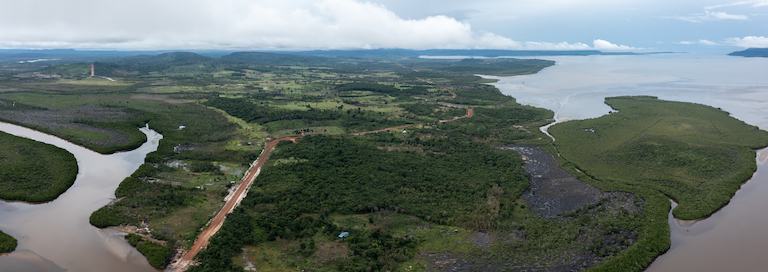
However, such tantalizing profitability has drawn investments from infamous tycoon Ly Yong Phat, who is reportedly building a bridge that connects National Road 48 to Chroy Pros village and across the water to Kiri Sakor district on the southern coast of Koh Kong, with the RCAF guarding the road and the river, effectively barring all access to Chroy Pros.
Now, sources within the commune say residents of Chroy Pros are being ordered out. Although they said the relocation has been “voluntary” so far, the presence of Chinese workers coupled with RCAF trucks and newly constructed barracks suggested that Tea Banh was involved in the development that threatened their homes.
Wary of being seen talking with outsiders, Samnang’s wife, Bopha, said she had previously spoken to journalists about the transformation of their coastal commune, but shortly afterward she had been summoned by both the commune chief and the district head and given a warning.
“They told me not to report anything,” she said.
“If they knew you’re a journalist, they would have stopped you immediately,” Samnang added. “They wouldn’t even let you in. Even if I had relatives come over, they’re not allowed to enter.”
“They are afraid that [letting in journalists] would destroy their plans,” Bopha said.
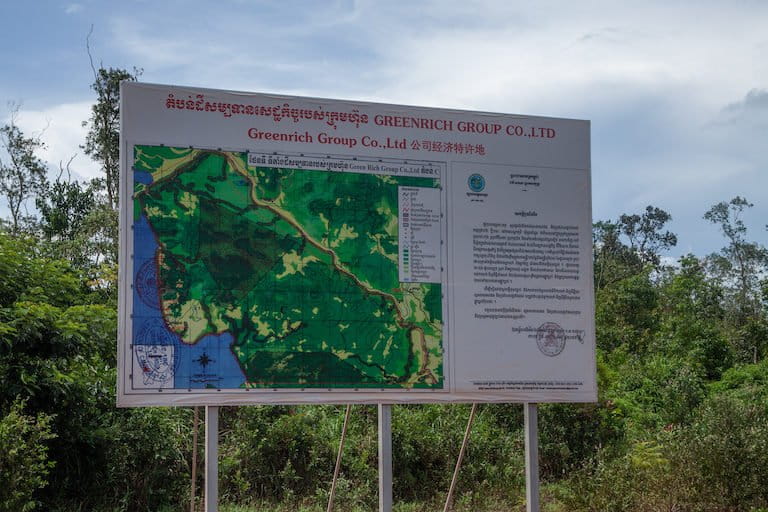
What’s known of the plans so far points toward something large-scale, the couple agreed, given the involvement of not only Koh Kong’s most prominent tycoon, Chinese developers and the defense minister, but also Chinese pulping company Green Rich, whose 1998 land concession in Koh Kong was reduced from more than 60,000 hectares to 18,300 hectares (148,300 acres to 45,200 acres) in 2003.
The initial concession was more than six times larger than the 2001 Land Law permitted economic land concessions to be, which are capped at 10,000 hectares (24,700 acres) per company — although it appears that Green Rich got around this by developing a six-year land-use agreement with the government in June 2011, where 10,000 hectares were to be used each year.
According to a 2007 document from the United Nations Office of the High Commissioner for Human Rights in Cambodia, the Ministry of Environment attempted to sue Green Rich in 2005 for logging beyond its concession. But both the Council for the Development of Cambodia and the Ministry of Agriculture, Forest and Fisheries testified in favor of Green Rich, and the Ministry of Environment’s appeal was dropped in 2006.
Neth Pheaktra, spokesperson for the Ministry of Environment, did not respond when questioned about Green Rich’s continued activity in Koh Kong or the legality of it.
In the 2011 agreement, the Ministry of Agriculture, Forestry and Fisheries and Green Rich, which has also gone by the name Green Elite, noted that fire damaged 70% of the company’s acacia plantation, prompting further suspicions that Green Rich was in fact a front for Indonesian pulpwood giant Asia Pulp & Paper (APP), and not interested in plantations, but rather logging.
Neither Green Rich nor Green Elite could be reached for comment, and APP, based in Jakarta, did not respond to multiple requests for comment.
While it remains unclear if Green Rich, or Green Elite, are in fact a front for APP, whose operations have attracted the ire of conservationists across Southeast Asia, the signage in Chroy Pros commune makes it abundantly clear that land the community occupies cannot be sold as it belongs to the company.
The sign goes on to threaten potential buyers or sellers of land with legal action, including the annulment of land sales by the Koh Kong provincial government, according to the signpost in Chroy Pros dated Aug. 4, 2020.
“We, the people, do not know what their plans are,” Samnang said. “The local authorities asked us 10 days ago whether we would move to live by the road, they asked people to volunteer for relocation, but we told them we need to know whether there would be a good house by the main road, whether there will be decent compensation.”
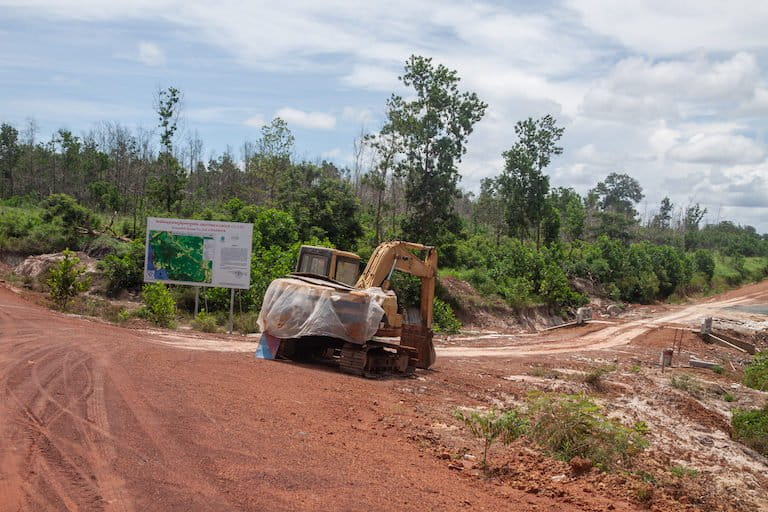
He said that, based on previous relocation efforts in Koh Kong, he only expected small plots to be offered.
“How can I take that? If they offer just square meters, we can’t even raise chickens. I should stay on my own land,” he added.
Samnang estimated that only between 10% and 20% of the Chroy Pros commune wanted to relocate, and that only those who didn’t own land or a house in the commune were choosing to do so.
Meanwhile, the land surrounding has been cleared on an industrial scale, with Samnang noting that he’d previously been detained for clearing land to farm. Yet no intervention had prevented the company from felling hectares of forest, he said.
Despite having lived in Chroy Pros commune since the time of the United Nations Transitional Authority in Cambodia in the 1990s, the couple said their attempts to sell their land earlier this year were blocked by the commune chief, who they dared not name for fear of reprisal. They said they had invested their savings of $3,000 in developing their property and were reluctant to move to a new area, given the bleak prospects offered to other communities who had been relocated within Koh Kong.
No land security or justice for victims of land grabs
In Srae Ambel district, part of the Dong Peng Multiple Use Zone, which lost 19,651 of its 27,700 hectares (48,559 out of 68,450 acres) to the sub-decree, Kheang Ra, a 38-year-old rice farmer, said he lost his 5-hectare (12-acre) plot of land three years ago to one of Ly Yong Phat’s many ventures in Koh Kong.

He had reluctantly accepted the relocation package of a half-hectare (1.2-acre) farm as compensation. But three years on, he said he has yet to receive the promised land title from local authorities.
“I wish the commune chief would hurry up and give us our land titles like we were promised,” Ra said. “I worry that if it takes too long, someone will come and take my land.”
He said everyone in his village had lost their land to Ly Yong Phat and had taken the relocation offers out of desperation. Ra said he had long since lost hope of getting fair compensation for his 5-hectare plot, but is now losing hope he will ever get a land title for his significantly smaller plot.
“They promised to give us more land, but so far all we’ve seen is more land going to wealthy investors. They have the money to bribe local officials [and] they’re working with them to secure the land that was promised to the people,” he said.
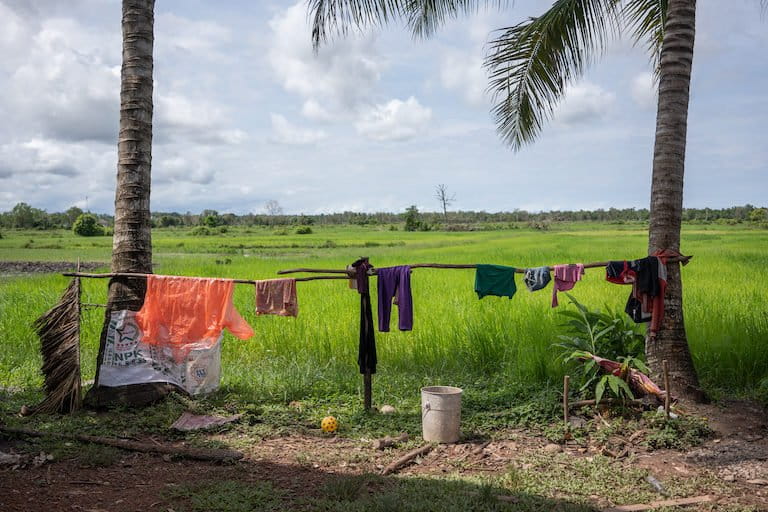
More than 25 residents from six districts in Koh Kong province all reported an increase in attempts to purchase their land or coerce them to relocate, while virtually none were aware of the land titling project that Sub-decree No. 30 purports to represent.
The desire for so many sources to remain anonymous stemmed from the involvement of local authorities in the recent land rush, coupled with the power that local officials have to render communities homeless — all of which appears to further enable massively wealthy individuals and politically connected companies to exploit the sub-decree and seize land reclaimed from protected areas.
Whether that land was ever genuinely designated for distribution among long-suffering communities has been questioned by those familiar with land rights issues in Koh Kong.
“It’s highly unlikely that justice to communities will be done,” said Sarah Milne, an environmental and social scientist and senior lecturer at Australian National University whose work has centered on Cambodia for nearly 20 years.
“The government does not have a track record in securing meaningful community tenure arrangements,” she said, adding that the relocation efforts in Koh Kong and the social land concessions appeared more likely to benefit logging companies than local communities.
Milne said local authorities have long been “notorious land dealers” on account of their control over soft land titling within the communities they’re supposed to represent, but warned that the social and ecological consequences of unchecked greed will be devastating for Koh Kong and Cambodia.
“If all of the forest is cleared, this is going to be disastrous for the environment: biodiversity, water quality, coastal systems, and Indigenous people too,” she said. “A lot is now at stake here.”
Banner image: A section of forest to be cut from Tatai Wildlife Sanctuary as part of Sub-decree No. 30 and the alleged relocation site for villagers living in Tatai Kraom beneath the Stung Tatai hydropower dam. Image by Andy Ball.
Hear this reporter discuss these issues further on a December 2021 episode of Mongabay’s podcast, listen here:
Feedback: Use this form to send a message to the editor of this post. If you want to post a public comment, you can do that at the bottom of the page.














